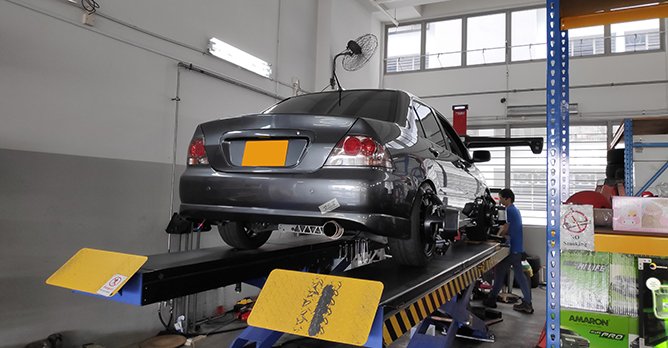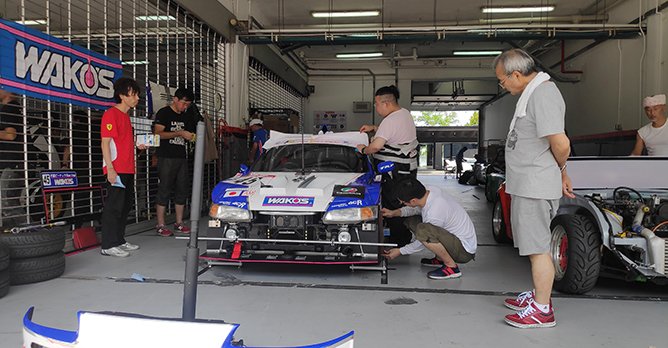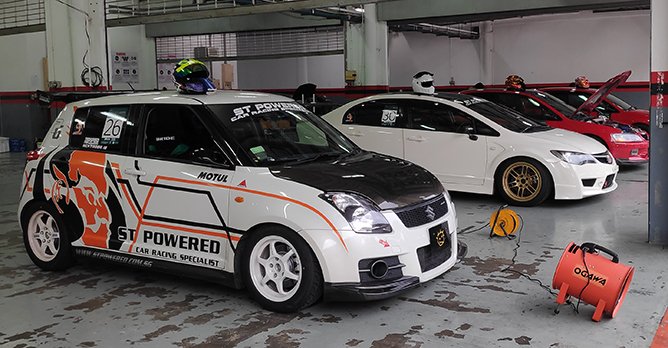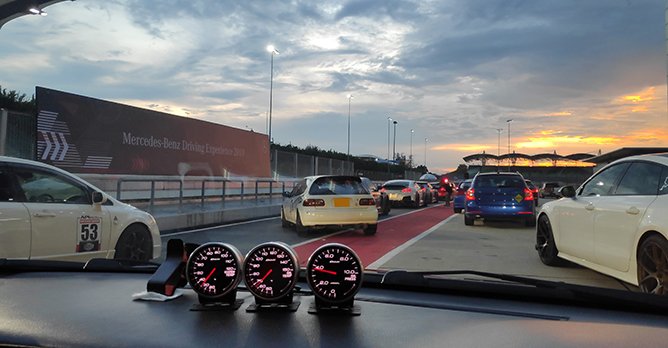6 things every track day beginner in Singapore needs to know
04 Jun 2020|20,319 views
Track driving is quickly gaining popularity everywhere in the world. It is a controlled environment where you can release your inner speed demon, a place where there isn't any speed limits or 'snipers' at overhead bridges to catch you for speeding.
So you decide to join a track day and give it a go, but where exactly do you start on this journey towards being a seasoned 'trackie'? No worries, we are here to guide you along with 6 track day essentials you need to know.
1. Signing up for a track day
The first step is to sign up for a track day event. As there aren't any race tracks in Singapore (aside from the temporary F1 GP circuit), you will have to head up to Malaysia to attend one. These days, track events are held at Sepang International Circuit and Melaka International Motorsport Circuit (MIMC). You can sign up for a track day with the various organisers, such as Traction Circle Club - a seasoned Sepang circuit open track day organiser, or the various workshops and private organisers. For first timers, it will be wise to go with a reputable organiser as they can often offer a smoother experience as well as better support in the case of emergencies.
Sepang is a 5.543km track, complete with 15 corners and two high-speed main straights. As a world-class circuit meant for cars, there are substantial run-off areas to ensure safety. The well-paved and wide road allows safe overtaking as well as the opportunity to explore racing lines. Meanwhile, MIMC is a much smaller track with a 1.7km length. As a repurposed Go-Kart circuit, it is narrower and filled with tight turns, which make it a challenging and technical course for cars.
2. Preparing your car for track

That said, there are still some vital parts on your car that should be checked or upgraded to ensure a safe and enjoyable track day experience. The first thing on the list is the rim and tyres. As the only point of contact to the road, the condition of your car's tyres is paramount to safety on the track. Stickier tyres can also get you improved lap times. Next are the brakes. Seriously, you wouldn't want to find out that your brakes aren't working only when you are travelling close to 200km/h down the main straight. Upgraded high-temperature brake pads, brake fluid and stainless steel brake hoses will come in handy as well.
Track driving is harsh on your car in all aspects, so do ensure that your car's engine (watch out for your car's water and oil temperature, and all fluid levels) and undercarriage components are in good condition. You wouldn't want to experience an engine failure or have any suspension components come loose while bombing down the race track. Also, remember to remove any loose items in the car, such as water bottles, umbrellas or any object that can dislodge and possibly get caught under a pedal - causing a disaster!
Finally, basic checks on your car's lights and indicators should also be done throughout the session. Be it on the road or at the track, being able to signal your intention to other drivers is paramount to safety.
3. Getting the mandatory equipment for track days
Here's the good news for every budding 'trackie'. There isn't a need for a full suite of professional equipment to enter a track day. Most of such events only require you to don a helmet (a simple open-face helmet meant for motorcycles is allowed) and covered footwear. Of course, there are no restrictions should you want to invest in more specialised safety equipment such as a full racing suit, racing harness and HANS (Head And Neck Support) device.
While not mandatory, it will also be good to download an application such as RaceChrono or TrackAddict on your smartphone, these apps uses GPS and the various sensors in your phone to track your lap times, offering priceless insight for you to review and improve your driving techniques.
4. Remember, a track day is not a race!
Cast aside your presumptions! Track day events are for drivers to explore their limits, attempt to set their own personal best lap times and have fun at the same time. It is not a wheel-to-wheel racing series, and there are no prizes to be won from overtaking others at the track. Everyone wants to get home safely, driving what they brought without a scratch.
Most track days adopt an open, 'free and easy' style. The track will be available to all drivers for the entire session, and drivers who want to enter the track simply have to queue up at the pit exit. There are usually no limits on the amount of cars in the track at any given time (hence events with lesser participants, though costly, are desired). Some organisers might also include time-attack elements, rewarding the drivers who set the fastest time in their respective class of car with a trophy to make the event more rewarding - ultimately, there really is no reason to go around overtaking others dangerously.
5. First time at the track - what to take note of
You need to be aware that there is a mixture of cars, as well as drivers with different levels of skill and experience at a track day. Safety is of utmost importance, and you should be attentive during the drivers' briefing session that's usually held before the start of a track session. You should not attempt to overtake at risky areas such as in the braking zone or corners. You will need to adhere to the lower speed limit in the pit lane for safety reasons. You should also be aware of approaching cars when exiting the pit - in the case of Sepang circuit, there is a white line on the road after the pit exit, you are to keep within the right side of the line to prevent obstructing cars approaching at speed.
If you are warming up, cooling down, or familiarising yourself with the track, you should turn on your car's hazard lights and stay out of the racing line, and away from approaching vehicles. You will also need to familiarise yourself with flag rules, though generally in track day sessions here, you will likely only see two colours, green flag - everything is fine, or red flag - there has been an incident on the track, the session is being stopped, reduce your speed, do not overtake, and return to the pits at the next opportunity.
6. In the event of a break down or an accident...

If your car can't move by its own power, be it due to a mechanical fault or an accident at the track, the cheapest option will be to get it towed to a trusted nearby workshop (your track day organiser should be able to recommend one). Alternatively, you can search for towing services that can tow your car back to Singapore (do contact your insurer through its roadside assistance hotline for its recommendation) - do note that this will be costly, expect upwards of a thousand Malaysia Ringgit. As such, you should always prepare extra cash on hand, you’ll never know when you’ll need it.
Here are some track related articles that you might be interested in
Cars that are great for track and everyday driving
6 types of car performance modifications that can make your car faster on the track
10 of the coolest looking Japanese car modifications right here in Singapore
Want to improve your car's performance before going for your first track day? Check out these car power enhancement workshops.
Track driving is quickly gaining popularity everywhere in the world. It is a controlled environment where you can release your inner speed demon, a place where there isn't any speed limits or 'snipers' at overhead bridges to catch you for speeding.
So you decide to join a track day and give it a go, but where exactly do you start on this journey towards being a seasoned 'trackie'? No worries, we are here to guide you along with 6 track day essentials you need to know.
1. Signing up for a track day
The first step is to sign up for a track day event. As there aren't any race tracks in Singapore (aside from the temporary F1 GP circuit), you will have to head up to Malaysia to attend one. These days, track events are held at Sepang International Circuit and Melaka International Motorsport Circuit (MIMC). You can sign up for a track day with the various organisers, such as Traction Circle Club - a seasoned Sepang circuit open track day organiser, or the various workshops and private organisers. For first timers, it will be wise to go with a reputable organiser as they can often offer a smoother experience as well as better support in the case of emergencies.
Sepang is a 5.543km track, complete with 15 corners and two high-speed main straights. As a world-class circuit meant for cars, there are substantial run-off areas to ensure safety. The well-paved and wide road allows safe overtaking as well as the opportunity to explore racing lines. Meanwhile, MIMC is a much smaller track with a 1.7km length. As a repurposed Go-Kart circuit, it is narrower and filled with tight turns, which make it a challenging and technical course for cars.
2. Preparing your car for track

That said, there are still some vital parts on your car that should be checked or upgraded to ensure a safe and enjoyable track day experience. The first thing on the list is the rim and tyres. As the only point of contact to the road, the condition of your car's tyres is paramount to safety on the track. Stickier tyres can also get you improved lap times. Next are the brakes. Seriously, you wouldn't want to find out that your brakes aren't working only when you are travelling close to 200km/h down the main straight. Upgraded high-temperature brake pads, brake fluid and stainless steel brake hoses will come in handy as well.
Track driving is harsh on your car in all aspects, so do ensure that your car's engine (watch out for your car's water and oil temperature, and all fluid levels) and undercarriage components are in good condition. You wouldn't want to experience an engine failure or have any suspension components come loose while bombing down the race track. Also, remember to remove any loose items in the car, such as water bottles, umbrellas or any object that can dislodge and possibly get caught under a pedal - causing a disaster!
Finally, basic checks on your car's lights and indicators should also be done throughout the session. Be it on the road or at the track, being able to signal your intention to other drivers is paramount to safety.
3. Getting the mandatory equipment for track days
Here's the good news for every budding 'trackie'. There isn't a need for a full suite of professional equipment to enter a track day. Most of such events only require you to don a helmet (a simple open-face helmet meant for motorcycles is allowed) and covered footwear. Of course, there are no restrictions should you want to invest in more specialised safety equipment such as a full racing suit, racing harness and HANS (Head And Neck Support) device.
While not mandatory, it will also be good to download an application such as RaceChrono or TrackAddict on your smartphone, these apps uses GPS and the various sensors in your phone to track your lap times, offering priceless insight for you to review and improve your driving techniques.
4. Remember, a track day is not a race!
Cast aside your presumptions! Track day events are for drivers to explore their limits, attempt to set their own personal best lap times and have fun at the same time. It is not a wheel-to-wheel racing series, and there are no prizes to be won from overtaking others at the track. Everyone wants to get home safely, driving what they brought without a scratch.
Most track days adopt an open, 'free and easy' style. The track will be available to all drivers for the entire session, and drivers who want to enter the track simply have to queue up at the pit exit. There are usually no limits on the amount of cars in the track at any given time (hence events with lesser participants, though costly, are desired). Some organisers might also include time-attack elements, rewarding the drivers who set the fastest time in their respective class of car with a trophy to make the event more rewarding - ultimately, there really is no reason to go around overtaking others dangerously.
5. First time at the track - what to take note of
You need to be aware that there is a mixture of cars, as well as drivers with different levels of skill and experience at a track day. Safety is of utmost importance, and you should be attentive during the drivers' briefing session that's usually held before the start of a track session. You should not attempt to overtake at risky areas such as in the braking zone or corners. You will need to adhere to the lower speed limit in the pit lane for safety reasons. You should also be aware of approaching cars when exiting the pit - in the case of Sepang circuit, there is a white line on the road after the pit exit, you are to keep within the right side of the line to prevent obstructing cars approaching at speed.
If you are warming up, cooling down, or familiarising yourself with the track, you should turn on your car's hazard lights and stay out of the racing line, and away from approaching vehicles. You will also need to familiarise yourself with flag rules, though generally in track day sessions here, you will likely only see two colours, green flag - everything is fine, or red flag - there has been an incident on the track, the session is being stopped, reduce your speed, do not overtake, and return to the pits at the next opportunity.
6. In the event of a break down or an accident...

If your car can't move by its own power, be it due to a mechanical fault or an accident at the track, the cheapest option will be to get it towed to a trusted nearby workshop (your track day organiser should be able to recommend one). Alternatively, you can search for towing services that can tow your car back to Singapore (do contact your insurer through its roadside assistance hotline for its recommendation) - do note that this will be costly, expect upwards of a thousand Malaysia Ringgit. As such, you should always prepare extra cash on hand, you’ll never know when you’ll need it.
Here are some track related articles that you might be interested in
Cars that are great for track and everyday driving
6 types of car performance modifications that can make your car faster on the track
10 of the coolest looking Japanese car modifications right here in Singapore
Want to improve your car's performance before going for your first track day? Check out these car power enhancement workshops.






















